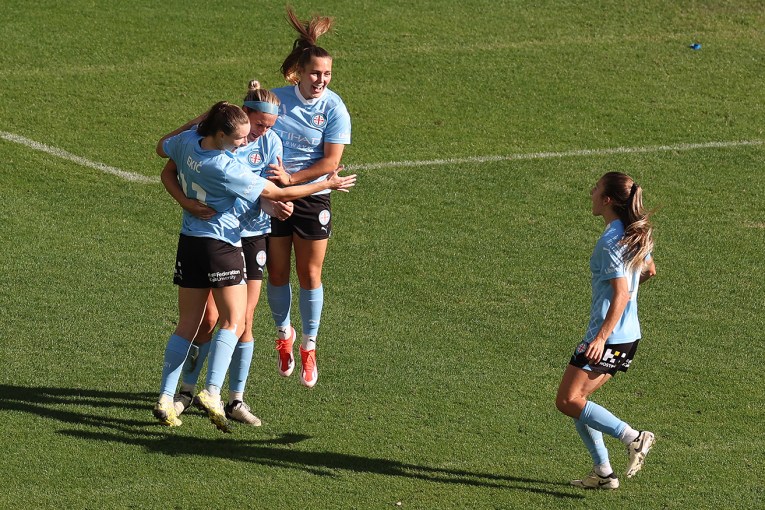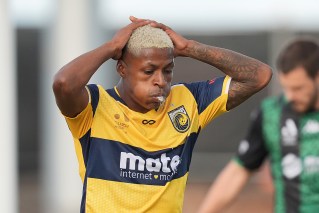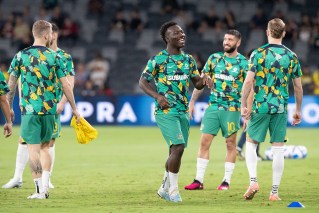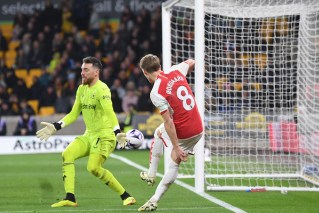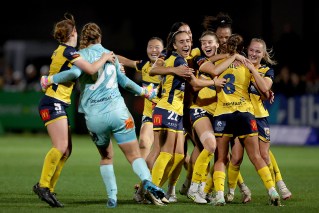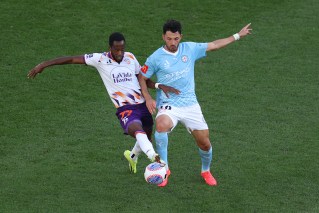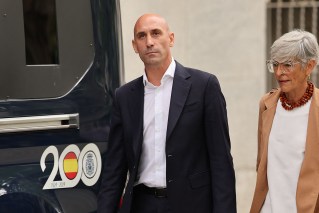Pele, the legendary Brazilian soccer player who rose from barefoot poverty to become one of the greatest and best-known athletes in modern history, has died at the age of 82.
The death of the only man to win the World Cup three times as a player was confirmed by his daughter Kely Nascimento on Instagram.
“Everything we are is thanks to you. We love you infinitely. Rest in peace,” she wrote early on Friday (AEDT).
Pele had been undergoing chemotherapy on a regular basis since he had a tumor removed from his colon in September 2021.
He also had difficulty walking unaided since an unsuccessful hip operation in 2012. In February 2020, on the eve of the coronavirus pandemic, his son Edinho said Pele’s ailing physical state had left him depressed.
Pele, whose given name was Edson Arantes do Nascimento, joined Santos in 1956 and turned the small coastal club into one of the most famous names in football.
Tweet from @England
In addition to a host of regional and national titles, he won two Copa Libertadores, the South American equivalent of the Champions League, and two Intercontinental Cups, the annual tournament held between the best teams in Europe and South America.
He took home three World Cup winner’s medals, the first time as a 17-year-old in Sweden in 1958, the second in Chile four years later – even though he missed most of the tournament through injury – and the third in Mexico in 1970, when he led what is considered to be one of the greatest sides ever to play the game.
He retired from Santos in 1974 but a year later made a surprise comeback by signing a lucrative deal to join the New York Cosmos in the then nascent North American Soccer League.
In a glorious 21-year career he scored 1,283 goals.
Pele, though, transcended soccer, like no player before or since, and he became one of the first global icons of the 20th century.
With his winning smile and an aw-shucks humility that charmed legions of fans, he was better known than many Hollywood stars, popes or presidents – many if not most of whom he met during a six-decade-long career as player and corporate pitchman.
He credited his one-of-a-kind mix of talent, creative genius and technical skill to a youth spent playing pick-up games in small-town Brazil, often using grapefruit or wadded-up rags because his family could not afford a real ball.
Pele was named “Athlete of the Century” by the International Olympic Committee, co-“Football Player of the Century” by world soccer body FIFA, and a “national treasure” by Brazil’s government.
His celebrity was often overwhelming. Grown adults broke down crying in his presence with regularity. As a player, souvenir-seeking fans often rushed the field following games and tore off his shorts, socks and even underwear.
His house in Brazil was less than a mile from a beach, but he didn’t go there for some two decades because of fear of crowds.
Yet even in unguarded moments among friends, he rarely complained. He believed that his talent was a divine gift, and he spoke movingly about how soccer allowed him to travel the world, bring cheer to cancer patients and survivors of wars and famine, and provide for a family that, growing up, often did not know the source of their next meal.
“God gave me this ability for one reason: To make people happy,” he said during a 2013 interview with Reuters. “No matter what I did, I tried not to forget that.”

Pele’s daughter Kely Nascimento confirmed his death in an Instagram post on Friday.
Pele’s astonishing goal record
Pele’s position as one of the greatest footballers of all time has never been contested but the same cannot be said for the number of goals he scored in his star-studded career.
Precisely how many time Pele hit the net is a matter of debate, with most statisticians agreeing it is between 1281 and 1283.
FIFA put his overall total at more than 1200 – more than 1000 of which came for his first club, Santos. Most of the others were for the New York Cosmos and Brazil.
Questions, however, have long surrounded the status of many of his goals, especially when compared to those scored by modern-day players such as Lionel Messi and Cristiano Ronaldo.
Almost half of Pele’s goals came in friendly matches – including games as an army conscript – and some argue they do not carry the same weight as goals scored in competitive matches.
Barcelona celebrated in December 2020 when Messi scored his 644th goal for the Spanish club, surpassing the 643 competitive goals Pele scored for Santos.
Two months later, Cristiano Ronaldo scored his 768th goal, three more than Pele’s total, including international goals.
Pele sent his congratulations to both players but his supporters still argue the Brazilian’s goal haul is superior because in Pele’s day friendly matches were much more competitive than they are today.
In the 1960s, South America’s top players were rarely snapped up by European clubs the way they are today, and the top teams from each continent hardly ever met in competitive games. So when they did face off in friendlies they were serious affairs.
Starting in the late 1950s, Santos toured Europe and much of the rest of the world every year because foreign clubs would pay them big money for the privilege of seeing Pele and co up close.
The tours were punishing. Santos would sometimes play two games in three days, and with no time to train, rest or eat properly they often slept on overnight trains and survived on fruit and chocolate.
And yet still they banged in the goals, from Lisbon to Lyon and Birmingham to Buenos Aires.
The defences Pele beat read like a who’s who of world soccer.
He scored against AC Milan, Juventus and Napoli; Real Madrid, Barcelona and Atletico; Anderlecht, Feyenoord and Red Star Belgrade.
He got eight goals in seven games against Inter Milan, six in five against AS Roma and 10 in seven matches against Benfica.
“You had to have a great prestige even to face teams like Real Madrid and Barcelona,” Odir Cunha, Santos historian, said.
“Pele played against some of the biggest teams in the world. And he scored against almost all of them.”
When Pele came to Australia
It is half-a-century since Pele played his one and only match in Australia but the occasion is still remembered.
He played for Santos, his club side, against the Australian national team in Sydney in June 1972 at the old Sydney Sports Ground.
Nearly 32,000 watched a 2-2 draw in which the Socceroos denied Pele a goal, though he did make a goal for the visitors.
Though this was an exhibition match, of the sort Santos played all over the world for many years to cash in on Pele’s fame, grainy black-and-white video of the clash shows it was fiercely competitive with Pele on the end of some tough tackles.
From one he was awarded a free-kick, which he took and cleverly set up Edu for Santos’ second goal.
The Australian team included many of the men who would make history as the first to play at a World Cup two years later, among them opening scorer Jim Rooney, Peter Wilson, Manfred Schaefer and Adrian Alston.
Ray Baartz, who missed out on the finals after his career was ended by an injury sustained against Uruguay in the World Cup build-up, scored Australia’s second goal.
After his retirement Pele made several trips to Australia. In 1990 he was mobbed in Sydney and Melbourne with fans queuing for hours to buy autographed books.
One of the more remarkable aspects was how many children – who could never have seen him play – were present.
Ian Chappell said at the time, “I have been fortunate to meet with and socialise with many great sportsmen and women, and play against them, but think he is the most impressive sportsman I have ever come across in my life.”
Current superstars of world football pay tribute
Brazil forward NEYMAR
Before Pele, “10” was just a number. I read that phrase somewhere, at some point in my life.
But that phrase, beautiful, is incomplete.
I’d say before Pele, football was just a sport.
Pele changed everything.
He turned football into art, into entertainment.
He gave voice to the poor, to the blacks and especially:
It gave visibility to Brazil.
Football and Brazil have elevated their status thanks to the King!
He’s gone, but his magic will remain.
Brazil captain THIAGO SILVA
Rest in peace ‘Rei’, God bless all his family,” Silva posted on Instagram
—
Argentina’s World Cup winner LIONEL MESSI
Messi posted a picture on Instagram of him with Pele with the message: “Rest in peace, @pele.”
—
CRISTIANO RONALDO
Ronaldo posted a picture of him receiving an award from Pele and wrote:
“My deepest condolences to all of Brazil, and in particular to the family of Mr. Edson Arantes do Nascimento.
“A mere “goodbye” to the eternal King Pele will never be enough to express the pain that currently embraces the entire world of football.
“An inspiration for so many millions, a reference from yesterday, today, forever. The affection he always showed for me was reciprocal in every moment we shared, even from a distance.
“He will never be forgotten and his memory will live on forever in each of us football lovers. Rest in peace, King Pele.”
—
French star KYLIAN MBAPPE
“The king of football has left us, but his legacy will never be forgotten,” French star KYLIAN MBAPPE he said on Twitter, posting a black and white photo of himself together with Pelé.
